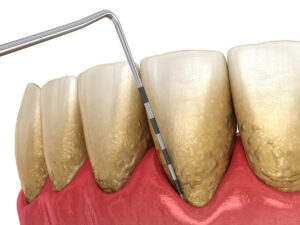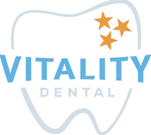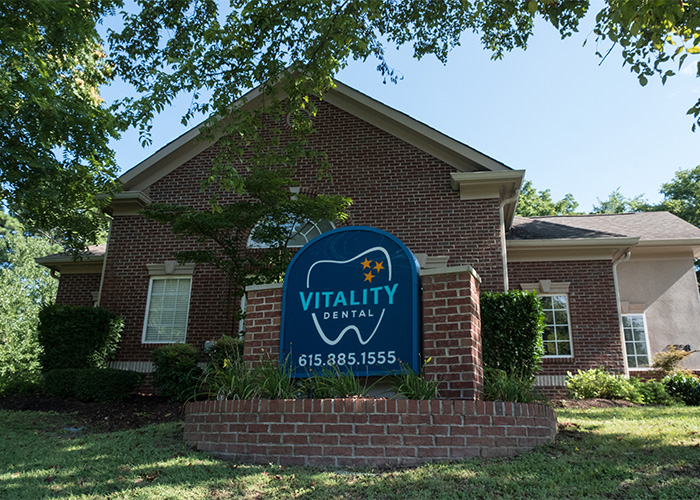Periodontal Disease Treatment
(Gum Disease)
Vitality Dental provides periodontal services, using non-invasive or laser treatment, for all stages of gum disease to restore your oral health. Gum disease is a serious condition that can affect anyone.
Don’t Suffer From Late-Stage Gum Disease
At Vitality Dental, we specialize in periodontal services and believe in using the most innovative treatment options, such as non-invasive Perio Trays™ or laser treatment. From scaling and root planing to more advanced laser treatments, we can treat any stage of periodontal disease. Suppose you’re experiencing any of the following symptoms. In that case, you may be suffering from periodontal disease:
- Overly sensitive gums
- Bleeding gums while brushing or flossing
- Chronic bad breath
- Loose or moveable teeth
- Visibly receding gum line
- Frequent toothaches
Don’t wait until you notice the signs of early-stage gum disease (gingivitis). Be proactive and schedule a routine exam and gum disease treatment with us at Vitality Dental.

-
What is Perio Protect?
Perio Protect is a non-invasive treatment method for periodontal (gum) disease that combines professional dental cleanings with a customized at-home regimen using Perio Trays™. These custom-fabricated trays are designed to deliver medication directly to the infected areas in the gums, targeting and managing the bacteria responsible for gum disease.
Your treatment length and frequency can vary based on your individual needs. This treatment aims to reduce inflammation and manage bacteria with the goal of potentially decreasing the need for more-invasive procedures. By focusing on both the treatment and prevention of gum disease, Perio Protect offers a comprehensive approach to improving oral health and maintaining a healthier mouth.
Visit Perio Protect -
What are the signs of periodontal disease or gum disease?
Periodontal or gum disease can be identified through the earliest signs of an irritated gum line. This might cause discomfort or even bleeding when you brush, floss, or have your teeth professionally cleaned. If left untreated, the gums will start to recede and pull away from the teeth, creating spaces between the teeth and gums, which are called periodontal pockets. These pockets can become a breeding ground for harmful bacteria. Furthermore, if gum disease reaches the jawbone and the connective tissues of teeth, the jawbone can deteriorate, leading to tooth loss.
-
What causes gum disease?
Three factors can cause gum disease. The most common cause is chronic periodontitis, which occurs due to poor oral hygiene. When bacteria accumulates beneath the gum line, it turns into tartar, a hard substance that cannot be removed by brushing or flossing. As a result, the gums get damaged and inflamed, and bone loss occurs. The second cause is aggressive periodontitis, which is a genetic condition that affects a small number of families and can even be seen in children. The last and the rarest cause is necrotizing periodontal disease, which happens in people who have immune or chronic diseases. This disease compromises the soft tissue and bone due to a lack of blood flow.
-
How do you treat gum recession?
At Vitality Dental, we offer three ways to treat gum recession:
- Medication: We may prescribe antibiotics if an infection is detected in the gums. Topical antibiotics such as antibiotic mouth rinse or gels with medicated relief may be used. Other medications may also be recommended to treat the underlying issue causing gum recession.
- Gum grafting: Our team can remove a small amount of healthy soft tissue from the roof of your mouth, in front of any teeth with disproportionate gum coverage, or from another donor source. Then, we attach it to the area where your gums have receded.
- Laser treatment: Laser treatment for gum recession has emerged as a minimally invasive and effective solution. With advanced laser technology, the procedure accurately removes diseased tissue and stimulates the growth of new, healthy gum tissue.
-
What is crown lengthening?
Crown lengthening is a dental procedure that serves both aesthetic and functional purposes. In Nashville, TN, our dental clinic offers this treatment option for patients who wish to improve the appearance of their smile or promote oral health. Excessive gum tissues can trap bacterial plaque underneath, increasing the risk of tooth decay and infection. Our experienced dentists can diagnose the root cause of your condition and consider both the functional and aesthetic aspects of your treatment plan.
More Questions?
If you have more questions about periodontal disease treatment in Nashville, TN, give us a call, and we will be happy to discuss further.
See All Dental Services Contact Vitality Dental Schedule Appointment

